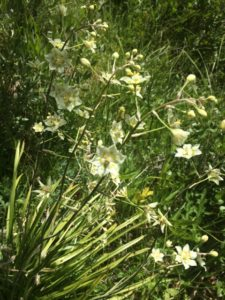
A Quick Guide to Our Flowers
The ecosystem that we have here in Stanley is incredibly different from other areas. We are considered a high desert area, which if you have visited here often or have lived in the area, then you know we do not get a whole lot of rain fall. However, the flowers that bloom in this area are magnificent, beautiful, and radiant. Many of these flowers brighten up the landscape as we drive to Ketchum or to Boise, and they give life to so many different creatures in our forests along our trails. This will be a quick guide to some of the most popular and important flowers, but there may also be new ones that you will learn!

Everyone knows what the infamous sunflower is, but here in Stanley we have a small cousin of the sunflower. These vibrant yellow petals and arrow-shaped leaves make identification quite easy. The arrow-leaved balsamroot (Balsamorhiza sagittata) can grow up to 2.5 feet tall with arrow-shaped leaves that can be up to 12 inches long. You can see this flower quite often on the Alpine Way Trail out of Redfish as you look over the lake and the mountains.

One flower that is incredibly stunning every time I see it (which is not that often), is the sego lily, or the mariposa lily (Calochortus nutallii). This flower is also easily identifiable by the soft white petals that have a splash of purple and yellow right in the center of each petal. The flower is endemic to the western U.S. which means that it will only grow out here! It is also the state flower of Utah, so lucky them! It will usually grow in sandy soils that drain well, meaning there is never a real excess of water present. You can normally see this cold hardy plant along the Fourth of July Trail, or near other high elevation sandy areas.

If you look closer to the ground, there is a small 5 petal plant that you may be able to see in a variety of colors within a couple feet of where you stand. This small star-shaped flower can grow in a wide array of locations, but we usually find them in open sunny areas here in the Sawtooths. Many people have taken these small flowers and placed them in their gardens where they create beautiful flower beds. However, in the mountains, phlox is simple to identify by its low coverage growth and bush-like habit. A large amount of phlox usually grows along the Fishhook Creek Trail out of Redfish.

We also have the ever so lovely elegant camas, but unlike other camas species, this flower is also known as death camas (Anticlea elegans). Death camas is an incredibly poisonous plant, so please do not eat it. You can identify this plant by the petal formation, where the 6 petals come together and form a star. There are yellow dots towards the base of each petal which attract pollinators to the center of the flower. It grows on a long green stalk where individual flowers shoot off from the main stem. These flowers are quite small in size, but the whole plant can stand up to 36 inches tall.

The final flower we will talk about today is fireweed (Chamerion angustifolium). This is a flower that is incredibly important for our ecosystem, and as you can probably see, it has a lot to do with fires. It grows to incredible heights of 8 feet! Seas of the vibrant pink flowers can be seen in areas with disturbed acidic soils, which is why many burn areas around here turn pink over time with fireweed. This flower eventually brings other creatures back into burn areas as well. Mice, bees, and elk all look to the fireweed in order to know when they should make their way back into an area. Places such as Grandjean are wonderful areas to go see some fireweed.

Although this quick guide only has a few flowers listed, these flowers are important to know, either for their popularity, or because of their importance in our ecosystem. Some wonderful plant identification books of this area are “Alpine Plants of the Northwest: Wyoming to Alaska”, “Edible and Medicinal Plants of the Rockies”, (both published by Lone Pine Publishing) and “Idaho Mountain Flowers” published by Larkspur Books. Plants are always fun and exciting to identify, at least in my opinion, because they cannot move locations, and the vast majority of one species looks the same. So if you take a picture, chances of you being able to identify it later are pretty high! Please remember though, when you are out enjoying the wildflowers that Stanley has to offer, leave them for other viewers. “Leave only footprints, take only pictures.”